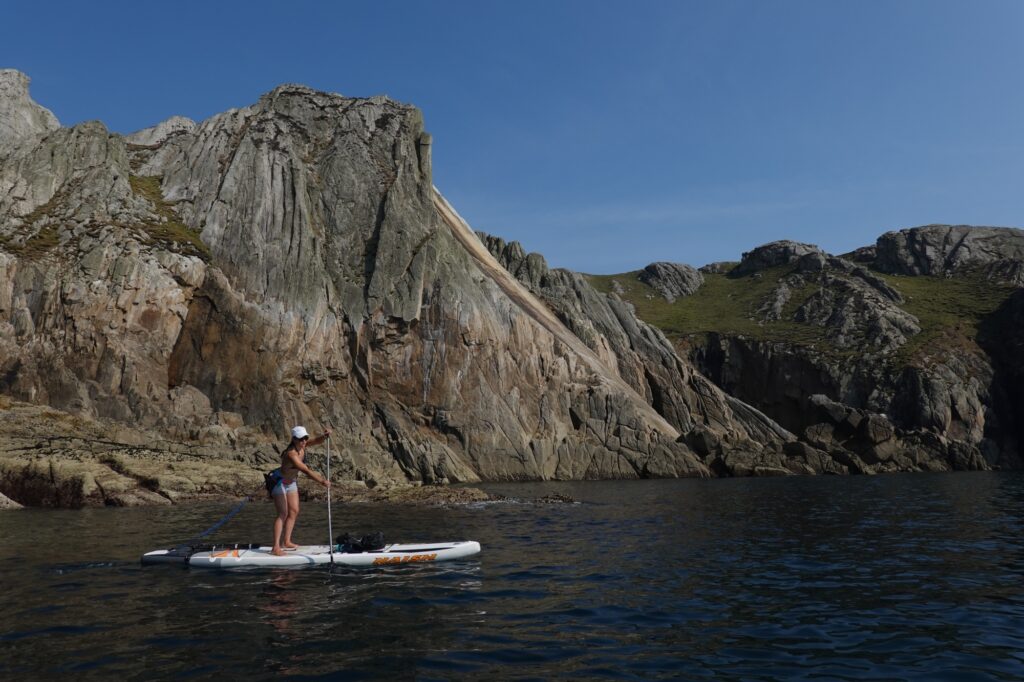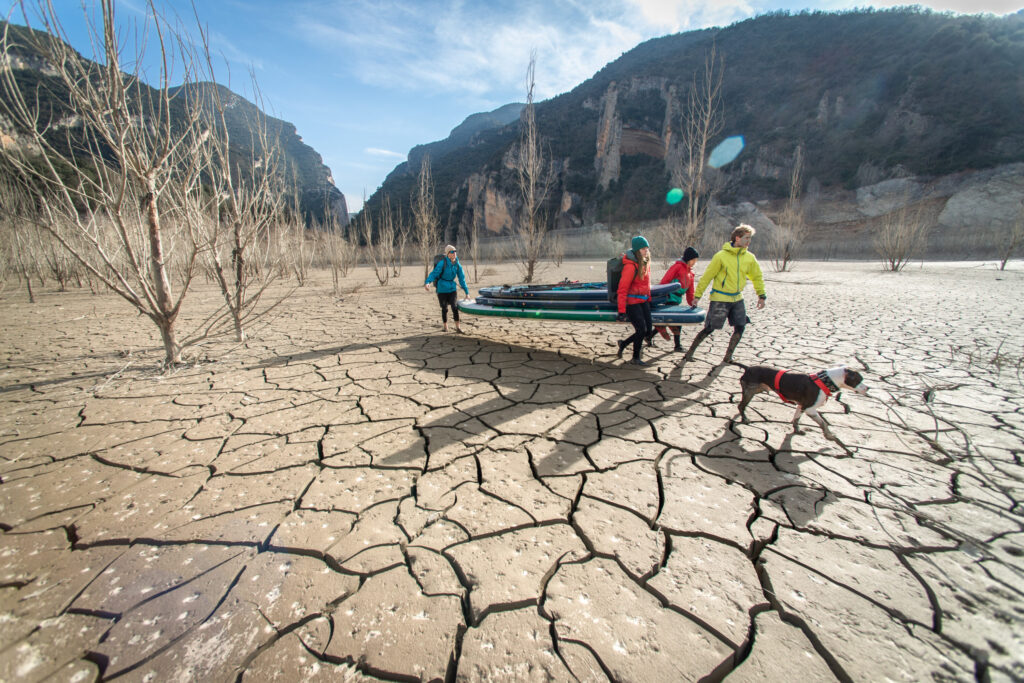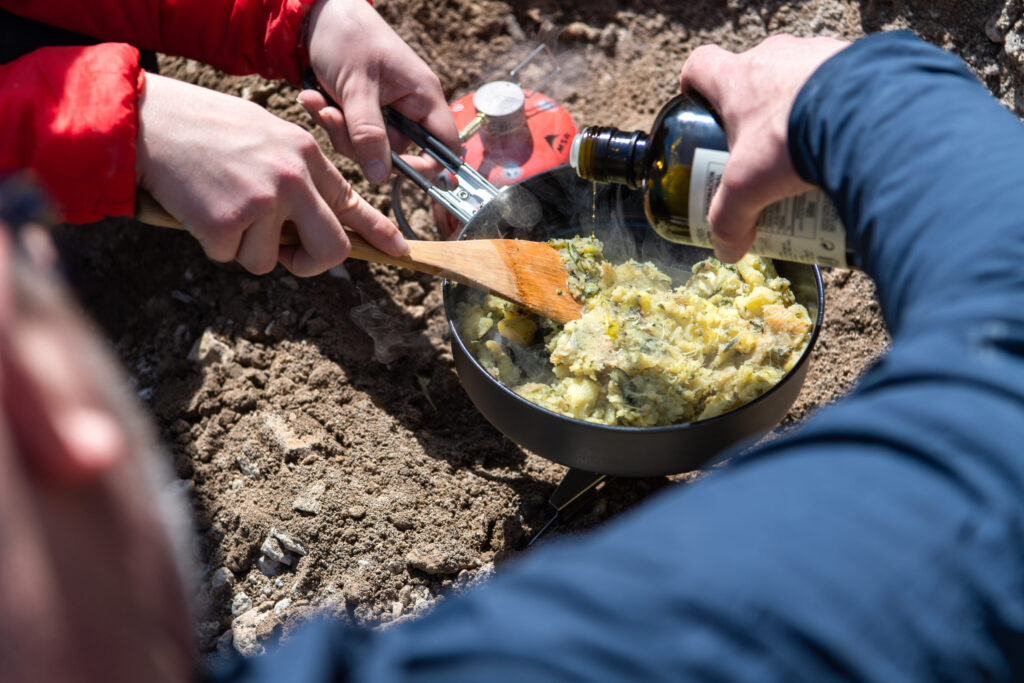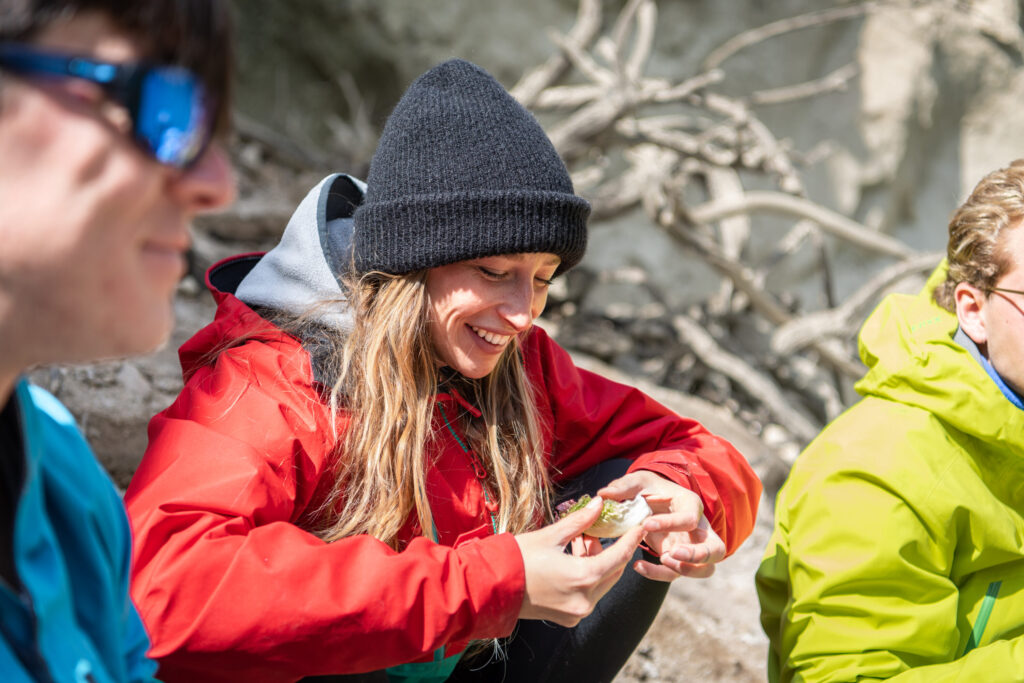Home Story Echoes from the Canyon
Echoes from the Canyon
Feature type Story
Read time 10 mins
Published Apr 26, 2022
Author Kieran Creevy
Photographer Lisa Paarvio
Paddleboarding in the placid canyons of Catalonia’s national parks might seem serene enough. As the team discovers though, the adventure really kicks in only when things start to go wrong. Kieran Creevy shares the adventure along with a couple of traditional regional recipes pairings to try yourself.

Scrambling down the steep slope, our heavy packs force us to choose our footing with care. At the bottom, river mud is baked and cracked. Our first steps break through the fragile surface and we sink to our knees.
Leaving behind some essential snacks with our team on the river, I shoulder my pack, departing on foot to our planned rendezvous. Ahead lies the stunning Congost de Montrebei National Park. As I hike uphill, I can hear the whistling of air being pumped into paddle boards. Dancing around the team is Eko, a massive branch clutched in his jaws, as he pleads for someone to play with him.
At the edge of the canyon I hear shouts of joy coming from high above. A hundred meters away on the Aragonese side of the canyon, ribbons of green and orange flicker in the sunlight. Climbers, hidden in the various folds and curves of the wall. High above the water below, these walls are a refuge for nesting vultures and eagles.
Snippets of Catalan echo up the walls from the river as the voices blend together, becoming muddled
The path narrows as I head deeper into the canyon and the cliff face curves over my head. Wire cables are anchored to the wall, providing reassurance and a lifeline for those who fear the void mere metres away. Far below the water turns into glorious shades of Prussian blue as the sunlight finally clears the ridgeline.
Snippets of Catalan echo up the walls from the river as the voices blend together, becoming muddled. Their original meaning lost.
Far below me, moving at deceptive speed, the SUP team dip their paddles in rhythm. The trail widens, and bends towards the forest again, I turn to stare in awe at the beauty of the landscape.
This rough hewn hiking track, constructed by hand, pales in comparison to the majesty of the canyon. Its walls carved into wondrous shapes, all smooth lines and curves, banded with colour.
The bands displaying geological forces and timelines beyond most of our comprehension. Unfortunately though this beautiful landscape, like so many others, is in danger.

All around us are the signs of massive drought, none more stark than the water level. Here, normally the river rises almost to the forest edge, now it’s almost 20 metres lower than that.
Here, in this gorge the river levels are down. On the other side of the planet, whole islands are about to be consumed by a sea that has risen less than a metre. It’s hard to comprehend what a 20 metre sea level rise would mean!
With the river far below its normal level, I descend on a fixed rope to a floating pontoon, anchored in a cove. Gingerly, I place my backpack on the tandem SUP, our food for the journey carefully cached inside.
As Chuan paddles us out into the slow current, we hear a splash close behind us. A sleek dark shape flows underneath, chasing carp in the depths.
We find a giant wave of stone, formed into a small cave around the next corner. The perfect place for our lunchtime refuel. Firing up the stove, and unpacking insulated containers, we soon have our simple tapas of Trinxat (typical Pyrenean dish made with potatoes, cabbage and pork meat.) While cooking, some of the team is at the river edge, filtering water for the next leg of the journey.
Normally the river rises almost to the forest edge, now it’s almost 20 metres lower than that

Bellies full, hydrated, and water bottles topped up, the team deposit me on the bank once more to continue my hike.
As the sun wanes, I’m outside the national park, waiting for the team at the river’s edge, but something has changed. This morning the river was placid, slow moving, shifting in colour from clear to green to light blue. Now it’s grey and brown, and small rapids start to form on the surface. Far upstream, one of the power companies operating here has opened its sluices, releasing a large amount of water carrying mud, stones and small bits of debris.
The call comes over the radio. The team has had to beach their SUPs far downstream, unable to paddle against the increasing current.
Between the team and I now lie kilometres of soft mudflats. Post-holing and crawling through hip-deep mud, while dragging behind a twenty kilo SUP is exhausting work. What should have been an easy paddle now becomes something much more complicated. Adventure it seems, begins when things go wrong.
For now my job is to check in with them at regular intervals to make sure they’re safe, and have food and water ready for when they arrive.
Hours later, they eventually round the corner on the opposite side of the river to where I am stood. We’re no more than thirty metres apart, but to reach me they’ll have to ferry glide across a much faster current.
Faces and hands streaked with dried mud, the team make it. They pull their paddle boards up the last few metres and crumple to the ground. Chests heaving, but with mile-wide grins, the flip over onto their backs, elated.
Tonight we feast on slow cooked Catalan stew, and sleep under moonlight, ready for whatever tomorrow brings.

Trinxat
Ingredients
- 1 head cabbage, cleaned, cut into 4
- 1kg potatoes, peeled and diced
- 8 cloves garlic, finely chopped
- 2 tsp black pepper
- 1 tsp nutmeg
- Sea salt
- Olive oil
Optional
- 4 Fatty bacon slices, finely diced
- 1 leek, finely diced
- Baby lettuce leaves to serve on the trail.
Method
In a big pot, bring salted water to the boil. Cook the cabbage for 10 minutes. Add the potatoes and cook for another 20 minutes.
Drain and mash together roughly. Season with salt and pepper to taste. Allow to cool slightly.
In a frying pan, heat up a little oil. Add the garlic slices, cook for 1-2 minutes. Add the mash and fry until there’s a good colour to the potatoes.
If you’re using bacon, add it after the garlic but before the mash.
Serve on a plate with Spanish Jamon, grilled black pudding or Bottifarra.
If you leave out the bacon, this is a great dish to chill then have on the trail for a hot lunch as it doesn’t have any animal fat.

Slow cooked rabbit stew
Ingredients
- 1 whole rabbit, cut into 8 (ask your butcher to do this) or 1.2 kg rabbit loin (left whole), plus 1 whole roasted chicken carcass
- 4 tbsp olive oil
- 8 cloves garlic, peeled
- 4 banana shallots, peeled and quartered
- 1 leek, cleaned and diced
- 1 jar roasted tomato puree
- 1 jar grilled red peppers
- 2 large potatoes, peeled and diced
- 4 carrots, peeled and sliced
- 1 glass red wine
- 1.5 litres good vegetable or chicken stock
- Sea salt
- 4 tsp ground black pepper
- 4 tsp smoky paprika
To serve
Pimentos de padron, roasted and salted.
Method
Season the rabbit with salt and 1 tsp black pepper.
In a large frying pan, heat the olive oil. Fry the shallots, garlic and rabbit until the rabbit is lightly caramelised. Spoon into a slow cooker set to medium.
If you’re using rabbit loin and chicken carcass, add both to the cooker. If you don’t have slow cooker, use a large stockpot, set on the lowest heat setting.
Add the rest of the ingredients to the cooker/stockpot. Simmer for six hours until the rabbit is falling apart.
Allow to cool then remove as many bones as possible as rabbit has a lot small bones which can be a choking hazard.
When cool, store in the fridge if eating at home and reheat the next day.
If you want to eat this meal on the trail
When cool, transfer the rabbit to insulated food containers (with the lids off) freeze hard overnight. Cap with the lids, and take with you on the trail.
A good insulated food container should keep the stew frozen for 5-6 hours, so on a full day hike, it should be thawed by dinnertime.
Don’t miss a single adventure
Sign up to our free newsletter and get a weekly BASE hit to your inbox
Other posts by this author

Story • Kieran Creevy • Jun 16, 2023
Scrambling Before Scran on Scotland’s Misty Isle
Sun-drenched ridge lines with expedition chef Kieran Creevy on the Isle of Skye

Story • Kieran Creevy • Aug 25, 2021
Calm Waters, Islands and Hidden Creeks
Kayaking and open fire wild cooking in the Swedish wilderness

Story • Kieran Creevy • Jun 02, 2021
Desert Heat And Mountain Storms
Exploring the trails and flavours of Andalusia

You might also like

Video • BASE editorial team • Apr 26, 2023
5 Tips For Taking Care Of Your Paddleboard
Expert advice for keeping your SUP in top condition

Story • David Pickford • Apr 12, 2023
West by Northwest: Lundy Island by Standup Paddleboard
An open-water SUP voyage from the north coast of Devon to the iconic island of Lundy

Story • Aaron Rolph • Nov 16, 2022
The UK’s Last Remaining Wilderness
A hike and SUP adventure to discover Knoydart, a wild peninsula in the Scottish Highlands
















